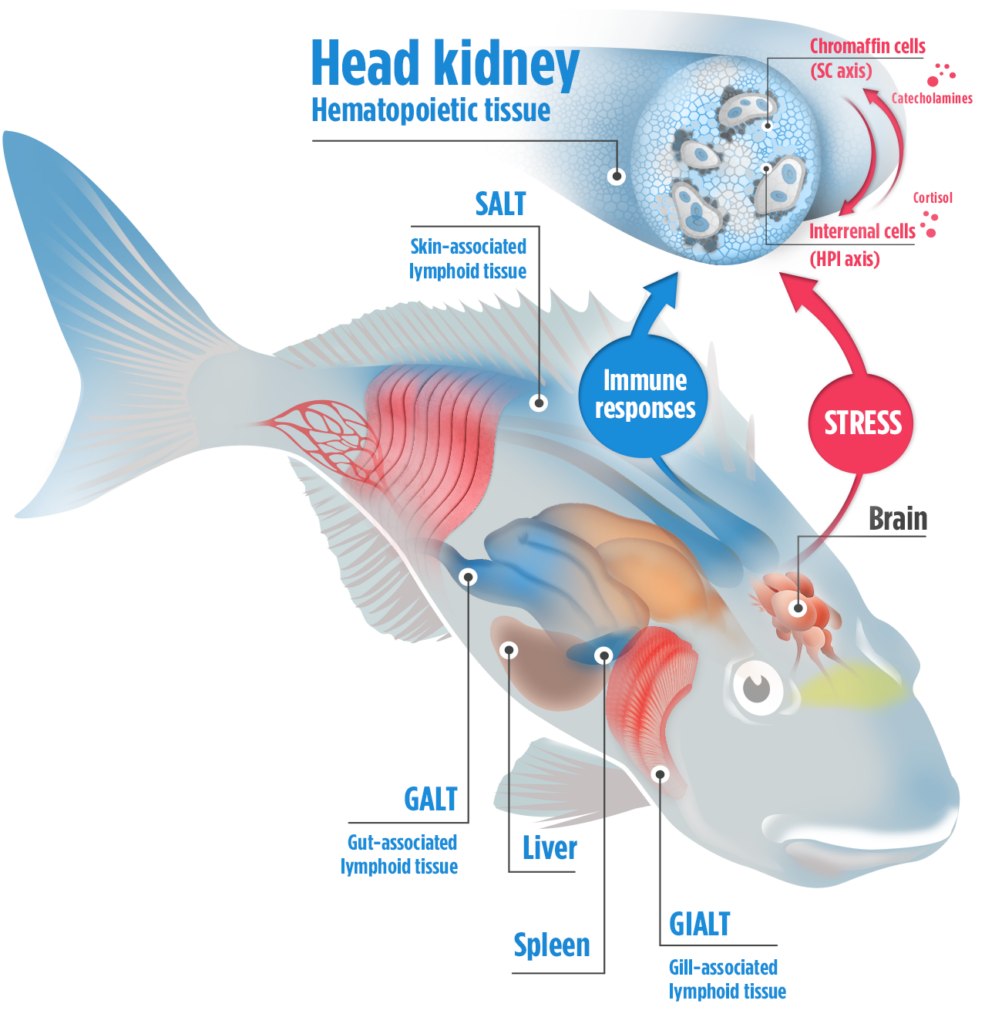
Fish stress and welfare
Stress episodes occur in all living species and the development of a stress response is a key mechanism for survival and recovery. Fish suffer different kinds of stressors, from environmental to anthropogenic ones, including those related to aquaculture and fish trade. In fish, stress responses are markedly species-specific, and depend strongly on the individual behavioural phenotype, sex, developmental stage and the type, resilience and seasonality of the stressor. We study the stress responses using a hierarchical approach, looking at different biological levels, from gene expression to cell and tissue function, to physiological responses, including the primary responses of hypothalamic-pituitary-interrenal (HPI) and sympatho-chromaffin (SC) neuroendocrine axes, and the secondary responses focused on metabolism, immunity and oxidative stress. The SC axis is involved in catecholamine-mediated fast responses leading to elevated heart rates, increased blood perfusion and glucose supply to branchial and muscular tissues. The activation of HPI axis helps to regulate metabolic and energetic trade-offs by using cortisol as a key modulator of lipid catabolic pathways and immune responses.
Welfare is the other side of the coin, as fish becomes unstressed. Although it is not easy to categorize welfare states in fish, the group has been involved in defining functional variables, behavioural patterns and health-related parameters to provide indicators for the well-being and husbandry of fishes. Common aquaculture practices may include acute or chronic stressful events characteristic of such mesocosmos systems, related to pathogenic blooms, changes in the quality of water, handling, high stocking densities, transport, complexity of the rearing environments, conspecific aggression rates, opportunistic parasites, abnormal behavioural patterns, etc. that must be addressed from a One Health perspective. In this sense, our group has been recently involved in the analysis of land-based RAS (recirculating aquaculture system) characteristics, and their advantages and suitability for more safe, healthy, and manageable production of Mediterranean fish species.
Environmental immunology of fish
Aquatic organisms endure a plethora of obligate and opportunistic pathogens, including virus, bacteria and metazoan parasites. The abundance of oceanic microbial communities, with estimates up to a million cells m/L, varies strongly with temperature and dissolved oxygen, and to a lesser extent, with salinity, nutrient content, and currents. This means that fish have evolved in environments prone to elevated, but irregularly distributed, pathogen loads and xenobiotic spillovers that have modeled their innate and adaptive immune responses, both in terms of dynamics and heterogeneity of cellular and molecular components. Fishes show a remarkable diversity of forms and life-cycles, and constitute roughly half of the species of extant vertebrates, ranging in size from the few mm of the Indonesian cyprinid Paedocypris progenetica, to the whale sharks (Rhincodon typus), that may grow up to 12 meters. Fish have also flourished in several extreme habitats, from hypoxic Andean lakes to deep-sea food-depleted oceanic chasms. Their immune system has adapted accordingly, diminishing some mammalian defensive features (such as immune memory or antibody diversity) while reinforcing others (isoforms of humoral components) in a strong species- and habitat-specific manner. In the last decades, human-induced changes in aquatic ecosystems, including, pollution, habitat degradation and expansion of invasive species, have been continuously testing the immune robustness of fish.
Our group has been involved in the determination of the structure and function of complement proteins in seabream (Sparus aurata), the phagocytic capacity of lymphocytes in fish, and the changes in the gene expression of transcripts related to inflammatory responses in commercial fish exposed to combined stressors, including husbandry stressors, vaccination procedures or emergent contaminants, that may enhance immune responses or induce immune suppression. We have extended the analysis of the mechanisms associated to immune-endocrine interrelationship to the mucosa-associated lymphoid tissues (MALTs) embedded in the gills skin and intestine, regarding to the innate and adaptive response of the these mucous surfaces as well as the endocrine, metabolic and genomic response to stress, inflammation and antigen activity in host-pathogen fish models.
Nanoplastics effects in fish
The United Nations refers to the triple interrelated planetary crisis of climate change, biodiversity loss, and pollution, as global urgent threat, as these stressors can compromise global ecosystem health, with serious implications for economic and social development. Emergent contaminants are a significant threat to ecosystem health worldwide, and its impact includes not only the immediate acute consequences, but also chronic, post-exposure conditions. Plastic pollution is one of the major challenges nowadays, with an estimated 4.8–12.7 million tons of plastic entering oceans every year, where they undergo UV degradation and thermooxidative weathering processes, leading to the formation of microplastics and, eventually, to nano-size particles (<100 nm). Nanoplastics (NPs) are one of the least studied types of plastic litter, and are considered potentially one of the most hazardous contaminants, because they have been shown to cross biological barriers and be accumulated in organisms, even at intracellular levels, accumulating in lysosomes.
Aquaculture fish consumption is in constant increase all over the world, and the presence of NPs in fish muscle represents an additional exposure route to nanoplastics for humans through the consumption of contaminated food. That is why our group has focused in the in vivo and in vitro effects of nanoplastics in Mediterranean mussels (Mytilus galloprovincialis), commercial species of fish, including gilthead seabream (Sparus aurata), European sea bass (Dicentrarchus labrax), and model fish species, such as zebrafish (Danio rerio) and goldfish (Carassius auratus). In all the species analysed we have observed that short- to medium-term exposure, uptake and accumulation of environmentally relevant concentrations of common NPs (mainly polystyrene nanoplastics) may exert oxidative stress, unbalances in lipid metabolism, and changes in the timing and dynamics of inflammatory responses. At higher doses, NPs may induce developmental alterations, genotoxicity, and histopathological changes in the digestive and branchial tissues of aquatic organisms. Nowadays, the presence and bioaccumulation of NPs in marine trophic webs, the development of tools for the study of the transgenerational effects of NPs exposure, and the impact on human health risk assessment are our main concerns.